Biography
Interests
Ashraful Kabir, M.
Department of Biology, Saidpur Cantonment Public College, Nilphamari, Bangladesh
*Correspondence to: Dr. Ashraful Kabir, M., Department of Biology, Saidpur Cantonment Public College, Nilphamari, Bangladesh.
Copyright © 2019 Dr. Ashraful Kabir, M. This is an open access article distributed under the Creative Commons Attribution License, which permits unrestricted use, distribution, and reproduction in any medium, provided the original work is properly cited.
Abstract
A survey is completed in a Cantonment School and College students (150 male and 150 female students). Result showed that O blood group was the highest (34%) and the lowest AB (9.33%). Overall blood group of 300 students the O was 34%, A 24%, B 32.67%, and AB 9.33%. In addition, Rh+ was found 96.67% and Rh- 3.33%. After observing male and female blood group separately B+ was the highest in male and O+ in female. AB+ which is universal recipient was found 14 (9.33%) in male and 13 (8.67%) in female and O- which is universal donor was 3 (2%) in both male and female out of 150 students each. Same type of parents B+ × B+, B+ × O+, and A+ × B+ showed the highest B+ in their son and O+ in daughter. So, this is obvious that blood group of human is controlled by multiple allele.
Introduction
ABO and Rh blood groups are the most studied blood systems among human populations due to their
clinical genetic and anthropological importance [1-3]. The discovery of ABO and Rh blood groups has
contributed immensely to blood banking services and transfusion medicine in preventing many of the
immunogenetic hematological and transfusion problems [4].
In any emergencies, we need to take blood from the others. In this case, need to know own blood group with Rh factor. During blood transfusion, we need to identify pathogenic microorganisms like HIV, hepatitis, papilloma virus in blood through screening. Blood group of human is depended on the racial matter. Each ethnic group always tries to marriage with same group and ultimately their blood group genotypes remain more or less same. Blood group is controlled by multiple allele and for this, it is very tough to identify only basing on parents blood group. In human body, we carry lots of alleles of blood group genes and which will be acted, this is still unknown. Antigen A and B both are dominant on O and A and B they are codominant when both are present. Rh positive is of course dominant on Rh negative. Universal donor and universal recipient are essential in blood transfusion in any emergencies. When a female is Rh negative and her husband is Rh positive their second offspring will die by erythroblastosis foetalis for producing anti Rh antibody. In this case, these types of parents should not take their second child. The objective of this study is to find out which blood group is available in male and female students and blood group of students which I have found are coming from what type of blood group with Rh factor of parents.
Materials and Methods
For this study, male 150 and female 150 students randomly selected by their written statements of their
blood group and parents. Science group students gave that report spontaneously but humanities students
were not aware of this. Collected reports put in a table for observing the highest and lowest blood group
with Rh factor. In my report, I have tried to show the highest number of blood group with Rh factor of
students alongside their parents also. Sometimes, students are questioned about blood group with Rh factor.
Results
Table 1 (Figure 1) is showing the maximum blood group with Rh factor of 150 male and 150 female students.
The highest was B+ (57) and the lowest A-. B- and, AB- (1) each in male students. On the other
hand, in female students the highest was O+ (50) and lowest A- (1).

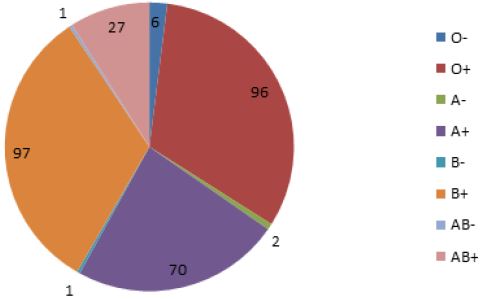
For the highest B+ blood group of male students and the highest O+ of female students mention their parents’ blood factor (Table 2).
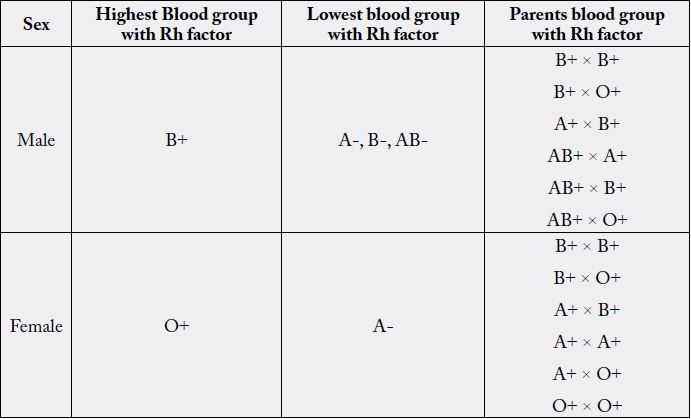
Out of 150 male students the highest was B (58) where the lowest AB (15) and in female O (53) was the highest and the lowest AB (13). Rh positive was 144 and 146 in male and female out of 150 students in each group (Table 3) (Figure 2).
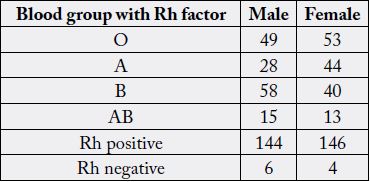
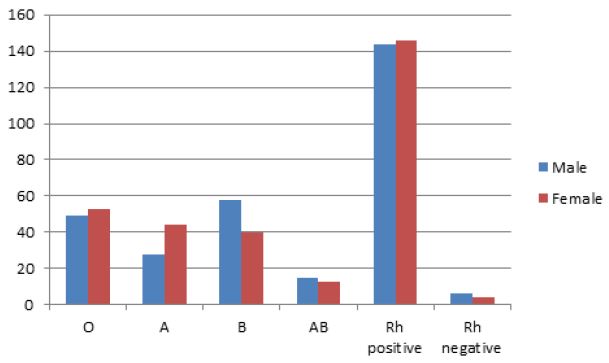
Average total percentage was the highest in case of O group (34%) and the lowest AB (9.33%). Rh positive was the highest (96.67%) in both male and female students (Table 4) (Figure 3).
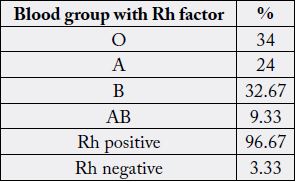
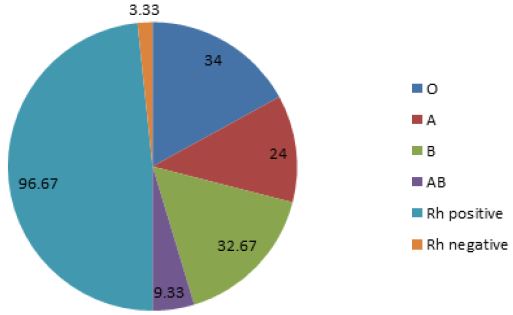
Table 5 is showing the universal recipient and universal donor of the students which are very important for receiving or donating blood in any emergencies.

Discussion
In Chinese and Bengalis only 1-5% may be Rh negative [5]. A strong evidence to suggest that there is an
association between AB blood group and certain like personality [6], intelligence [7], and diseases [8-12].
In Bagdad College of Science, Hasson showed that patient with blood group O had higher rate of the
hemodialysis in compare with other blood groups [9]. Blood group positive were at great risk of upper gastric
and duodenal ulcer than other group [8], also there is a study in India said that there is no relation between
blood group and diabetes mellitus [11]. Thompson [13] in 1936 found that there is no relationship between
blood group type and intelligence, emotion, idiosyncrasies or personality. A study by Ibraheem (2016) [14]
mentioned blood group O 42%, A 28%, B 20.8% and AB 8.4%. A previous Ethiopian report showed O
40%, A 31%, B 23%, and AB 6% [15]. Among African-American ABO blood group, the distribution of
type O 46%, type A 27%, type B 20%, and type AB 7%. In Caucasians in the United State, type O 47%,
type A 41%, type B 9%, and type AB, 3%. Also among western Europeans, type O 46%, type A 42%, type
B 9%, and type AB 3% [16,17]. Atire in 2015 [18] found O 40%, A 31%, B 23%, and AB 6%. This report
is very similar with Muhammad Jaff (2010) [19] where blood group O was 35.4%, A 22.5%, B 32.2% and
AB 8.7% and Patel (2012) [20] who reported Rh positive 92.92% and Rh negative 7.08% in female.
Conclusions
Each student should know their blood group with Rh factor alongside their parents. This is very important
decision for their entire life. If any emergencies arise, anyone can take or give blood and that time
knowing this group is very important. Science students are basically well-known about their blood group
whereas maximum humanities group students were not concerned with this. Rh factor is another point
for remembering in second child’s death for erythrobla++stosis foetalis. If female is Rh negative and her
husband is Rh positive, their second child may die by this incident. Rh negative female should try to avoid
Rh positive male for marrying. Blood group is controlled by multiple allele. For instance, if mother is B+
and father A+ but their offspring is O+. This incident is nothing but if mother’s blood group genotype is
BO and father is AO then from both OO if added may reproduce O blood group children. In intermediate
college students, they have a chapter of this blood group with Rh factor. So this is very important for their
academic purpose. A zoology teacher always tries to clarify this to their students. Blood is the main indicator
for any diseases in human body. Through hematological test, we easily understand any problems within the
blood and blood group with Rh factor. Within our relatives, we can easily donate blood to others. For social
welfare or through blood banking by understanding this blood group we can help others. Inheritance or
genetics of blood group of human is very interesting for its multiple allelic patterns. Somebody says blood
group can be changed but this is wrong. Sometimes, several pathological centers can detect different blood
group of the same people. This is just a wrong detection due to wrong or date-expired chemicals. In this case,
everybody should test their blood group with Rh factor several times and this will be of course minimum
three. Universal recipient and universal donor students should maintain their secrecy for blood receiving or
donating especially universal donor can donate their blood to everybody so here secrecy is more important.
They will donate blood in severe cases.
Bibliography

Hi!
We're here to answer your questions!
Send us a message via Whatsapp, and we'll reply the moment we're available!